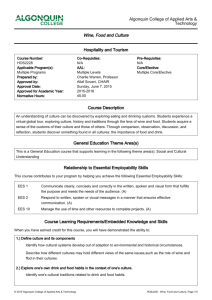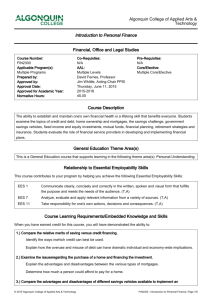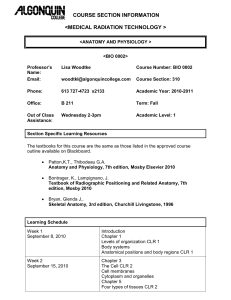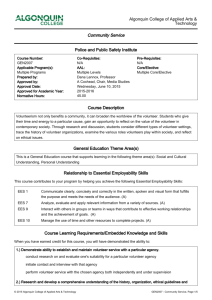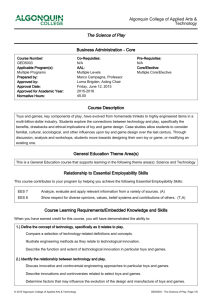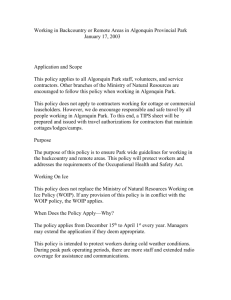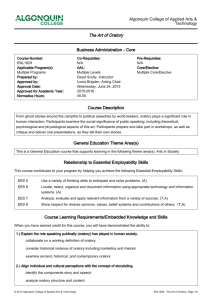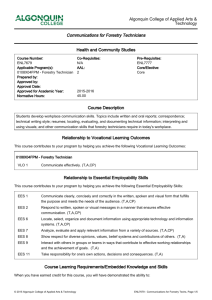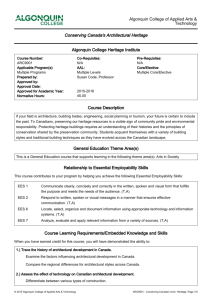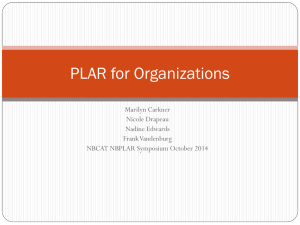Sample Course Outline for ZOO6100
advertisement
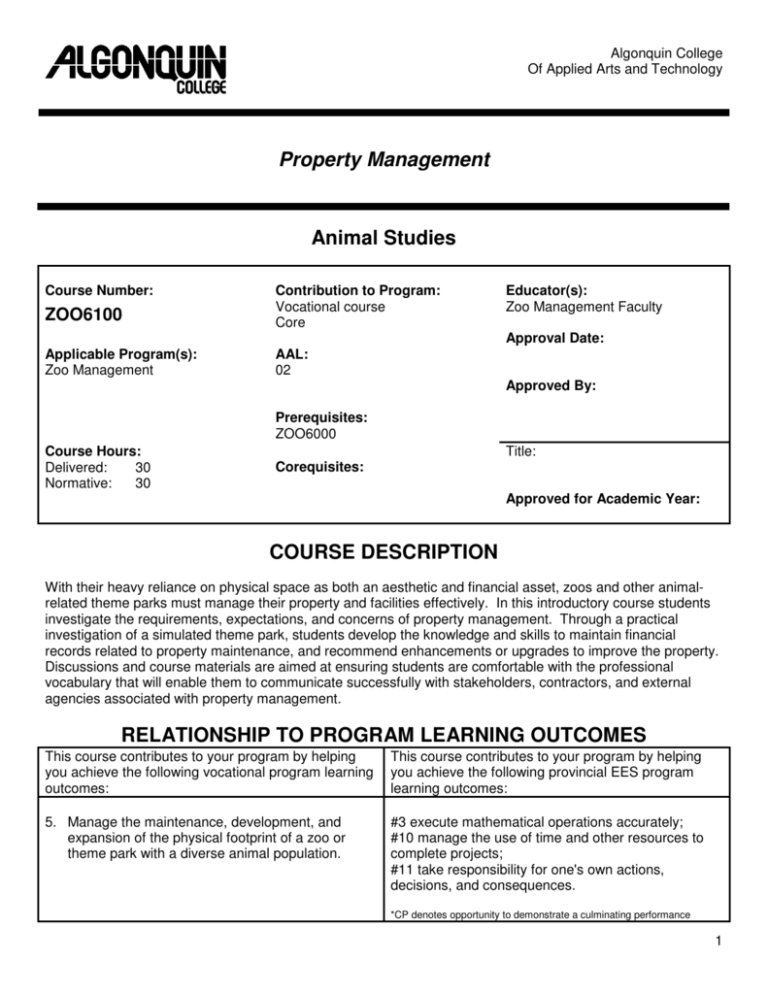
Algonquin College Of Applied Arts and Technology Property Management Animal Studies Course Number: ZOO6100 Contribution to Program: Vocational course Core Applicable Program(s): Zoo Management AAL: 02 Educator(s): Zoo Management Faculty Approval Date: Approved By: Prerequisites: ZOO6000 Course Hours: Delivered: 30 Normative: 30 Title: Corequisites: Approved for Academic Year: COURSE DESCRIPTION With their heavy reliance on physical space as both an aesthetic and financial asset, zoos and other animalrelated theme parks must manage their property and facilities effectively. In this introductory course students investigate the requirements, expectations, and concerns of property management. Through a practical investigation of a simulated theme park, students develop the knowledge and skills to maintain financial records related to property maintenance, and recommend enhancements or upgrades to improve the property. Discussions and course materials are aimed at ensuring students are comfortable with the professional vocabulary that will enable them to communicate successfully with stakeholders, contractors, and external agencies associated with property management. RELATIONSHIP TO PROGRAM LEARNING OUTCOMES This course contributes to your program by helping you achieve the following vocational program learning outcomes: This course contributes to your program by helping you achieve the following provincial EES program learning outcomes: 5. Manage the maintenance, development, and expansion of the physical footprint of a zoo or theme park with a diverse animal population. #3 execute mathematical operations accurately; #10 manage the use of time and other resources to complete projects; #11 take responsibility for one's own actions, decisions, and consequences. *CP denotes opportunity to demonstrate a culminating performance 1 Algonquin College Of Applied Arts and Technology COURSE CURRICULUM I. Course Learning Requirements/Embedded Knowledge and Skills Course Learning Requirements: Knowledge and Skills When you have earned credit for this course you will have demonstrated an ability to 1. discuss issues, expectations, and requirements of property management in a coherent and professional manner. • • • • • • 2. establish a schedule for effective and efficient maintenance of property and facilities. • • • • • 3. maintain accurate records related to a property's financial status, including a statement of accounts, and a property valuation. • • • • • • 4. propose a plan for expanding an existing property that is consistent with activities, environments, and resources already in place. • • • • • • identify standard usage and definitions of property management vocabulary. use positive communication techniques to project a professional manner. express opinions and conclusions in a clear and logical fashion. describe the benefits and drawbacks of a property and its facilities with discipline-specific language. explain applicable legal requirements and industry standards. monitor national and international associations for changes in legislation, policies, and standards. survey a property and its facilities. document maintenance requirements. estimate duration of a maintenance cycle based on existing resources. justify additional resources based on proposed modifications to the maintenance cycle. analyze trends in property and facility usage to improve the scheduling of maintenance. calculate the present value of a property. account for changes in the economic environment and their impact on property value. use accounting principles to track costs associated with property management. provide written support for financial decisions. show acceptable levels of amortization for substantial projects. ensure records are up-to-date and available for an external review. gather requirements and input for the use of new property and facilities. document the features of existing activities and environments. predict the impact of expansion on the property's value. estimate the financial investment required for the expansion. outline the impacts of expansion on stakeholders. liaise with contractors, consultants, and external agencies to ensure accuracy of information and compliance with legal requirements. 2 Algonquin College Of Applied Arts and Technology 5. adapt to changes in project timelines, resources, and requirements. • • • • • II. define the nature and extent of changes that arise. describe the impact of changes on related parts of the project. prioritize changes based on their urgency and impact on project requirements. recommend opportunities for adjusting project timelines to account for changes. justify extensions to project completion dates. Learning Resources Required texts Beirne, Mike. The Property Management Tool Kit. American Management Association, 2006. Griswold, Robert S. Property Management for Dummies. John Wiley & Sons, 2001. Other resources • Internet resources. • Algonquin College Learning Resource Centre electronic and print resources. III. Learning Activities Samples of learning activities may include: — locate and acquire information from texts and other reference materials — work with a simulated animal-related theme park — participate in discussion groups — tour facilities and identify maintenance needs — prepare financial records IV. Evaluation/Earning Credit The following will provide evidence of your learning achievement: Assignments Value Quizzes and In-Class Assignments to test key terms and concepts (Throughout the semester) (Validates CLR #1, 2, 3, and 4) Property Accounts Audit (On short notice, within the context of the simulation after Week 5) (Validates CLR #3, and 5) Response to Auditor's Report (After week 5; deadline included in Auditor's Report) (Validates CLR #1) Maintenance Schedule (Week 7) (Validates CLR #2, and 5) 10% 20% 10% 15% Mid-term Summary and Performance Self-Reflection (Focus on application of concepts and identifying areas that require strengthening) (Week 8) Updated Maintenance Schedule (Week 10) (Validates CLR #2, and 5) Expansion Proposal (Week 13) (Validates CLR #1, and 4) 5% 10% 20% Final Summary and Performance Self-Reflection (Focus on assignment results and integrating feedback into future practice) (Week 15) 10% TOTAL 100% 3 Algonquin College Of Applied Arts and Technology Grading System Percentage Conversion Course learning outcomes are met in a consistently outstanding manner Course learning outcomes are met in a consistently thorough manner Course learning outcomes are met satisfactorily Course learning outcomes are met at a minimal level of achievement Course requirements not met Letter Grade A+ A AB+ B BC+ C CD+ D DF FSP % Grade 90 – 100% 85 – 89% 80 – 84% 77 – 79% 73 – 76% 70 – 72% 67 – 69% 63 – 66% 60 – 62% 57 – 59% 53 – 56% 50 – 52% Numeric Grade 4.0 3.8 3.6 3.3 3.0 2.7 2.3 2.0 1.7 1.4 1.2 1.0 0 0 Prior Learning Assessment and Recognition Evidence of learning achievement for PLAR candidates will include: A challenge exam and assignment based on the course learning requirements listed above will be established by faculty and the PLAR Coordinator. Please consult the PLAR Office if you feel you are a candidate for PLAR. RELATED INFORMATION If you are a student with a disability, it is strongly recommended that you identify your needs to the professor and the Centre for Students with Disabilities (CSD). Algonquin College provides all full-time students with an e-mail account. This is the address that will be used when the College, your professors, or your fellow students communicate important information about your program or course events. It is your responsibility to ensure that you know how to send and receive e-mail using your Algonquin account. Students, it is your responsibility to retain course outlines for possible future use to support applications for transfer of credit to other educational institutions. 4

